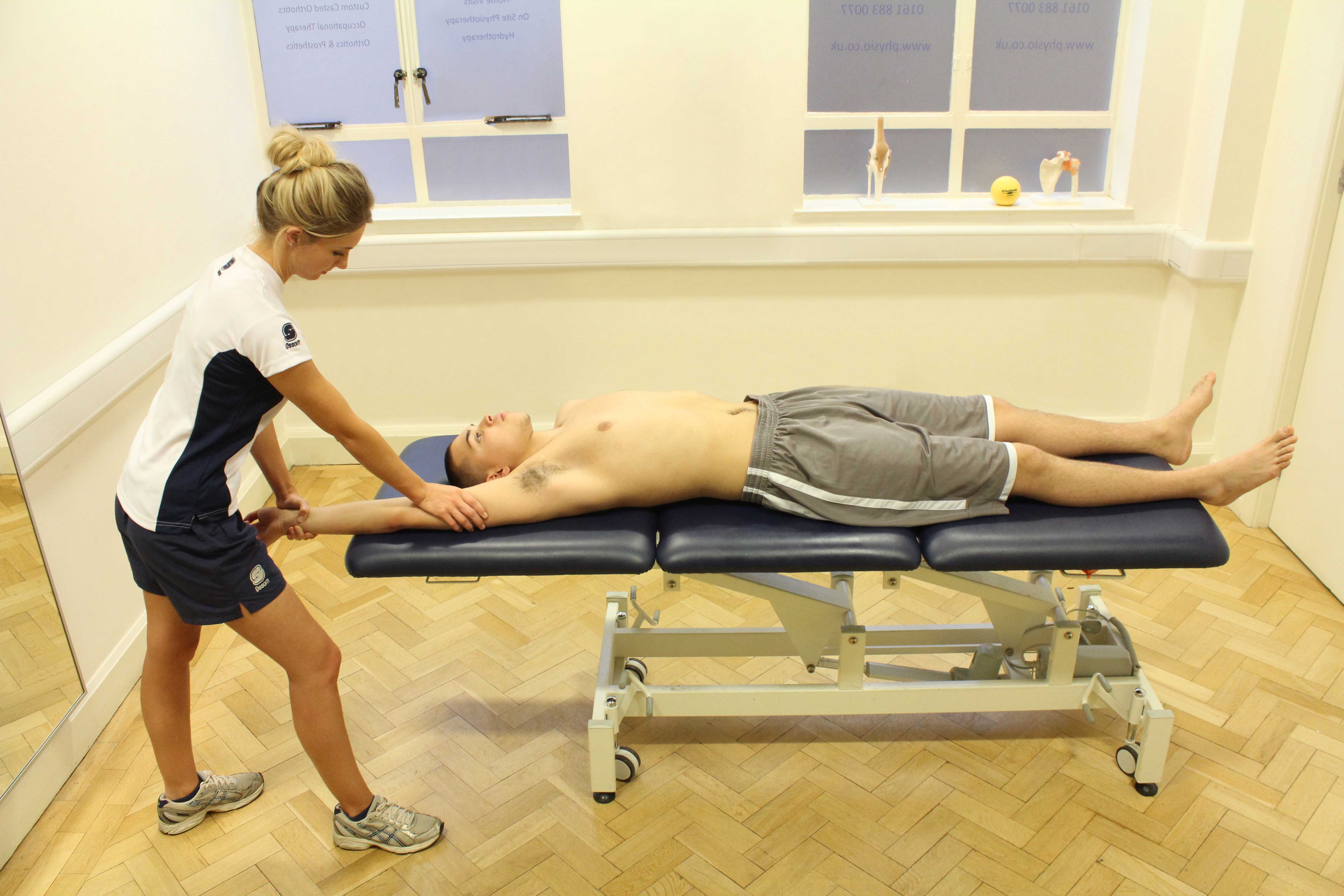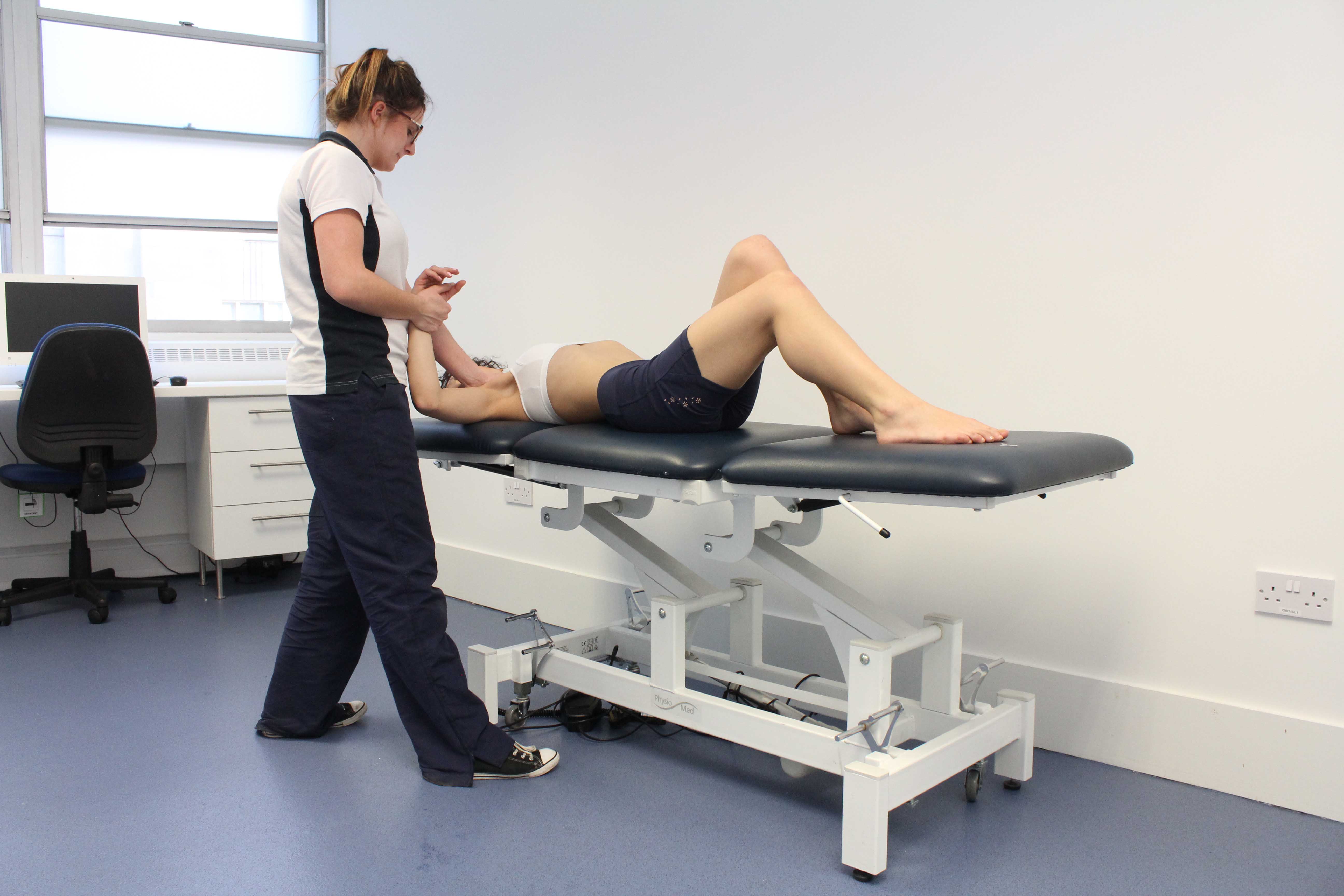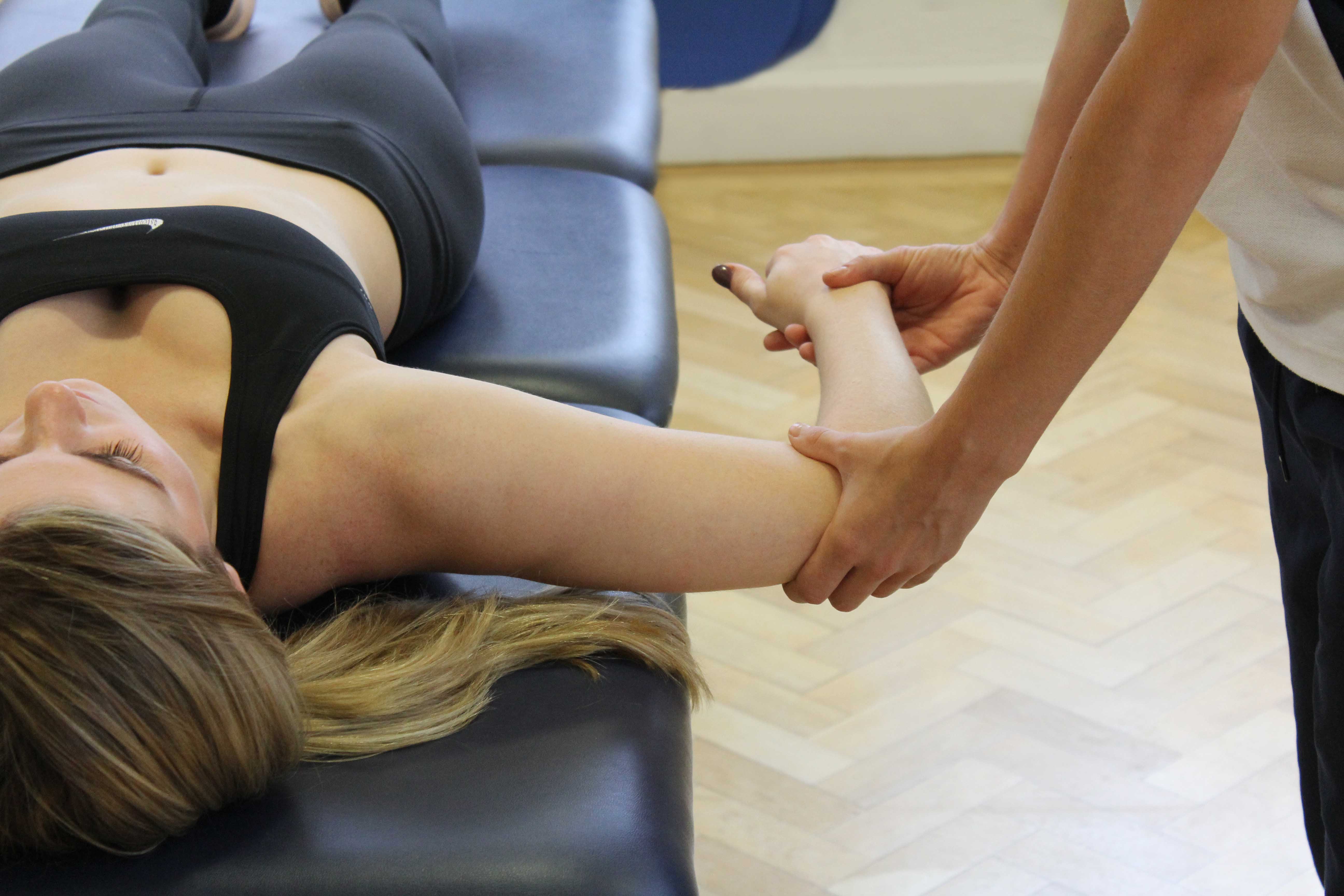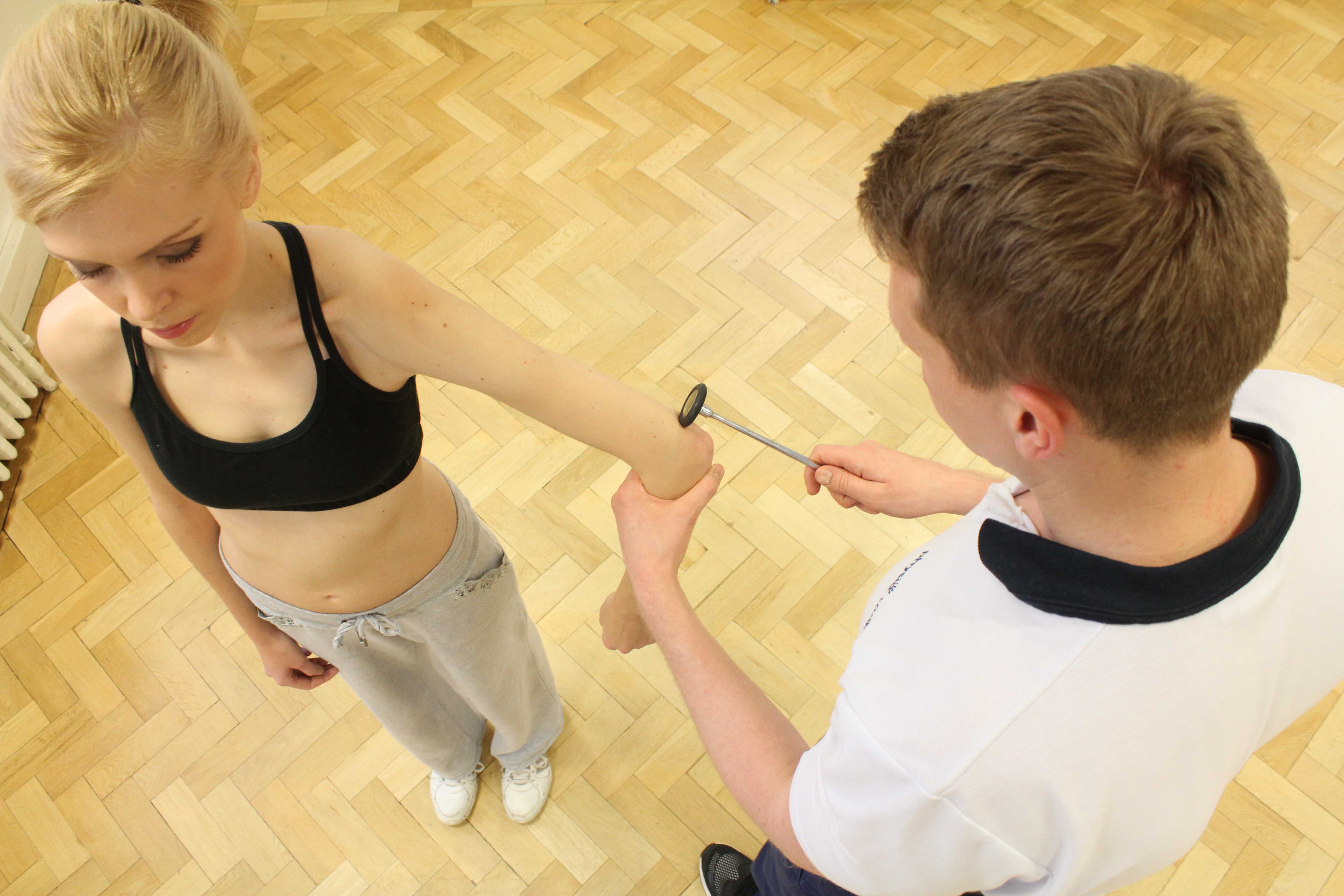The elbow joint is composed of the ends of the humerus (upper arm bone), the ulna (larger bone of the forearm, on the opposite side of the thumb), and the radius (the smaller bone of the forearm that makes up elbow joint on the same side as the thumb). Fractures of the elbow are a result of direct trauma or a fall onto an outstretched hand. In this position, the elbow joint is extremely vulnerable and the strong force that is applied causes part of the joint to fracture. Approximately 60% of the body weight is forced onto the elbow joint during a fall, and especially to the radial head. Additionally, conditions such as osteoarthritis put the elbow at higher risk of fracture after a fall.
Elbow fractures can occur at the humerus (upper arm bone), at the head of the ulna (larger bone of the forearm), at the head of the radius (smaller bone at top of forearm) or fractures can affect a combination of these articulations (joint ends).
A fracture to the elbow can either be displaced (out of position), non-displaced (in position), comminuted (3 or more fragments of bone) or can occur along with an elbow dislocation. If the fracture is undisplaced or minimally displaced then surgery may not be required. If a fracture to the elbow is significantly displaced or comminuted then ORIF surgery will be necessary.
During ORIF elbow, the incision made and surgical approach depends on the structures that are involved. The fractured ends are then realigned (open reduction) and held in place with a combination of pins, screws, and wires (internal fixation). It is important to undergo ORIF immediately after suffering a displaced fracture of the elbow as this will reduce pain, aid the healing process and prevent any further problems or injuries in the future.
Physiotherapy is imperative once the fracture site has healed sufficiently as this will maximise the success of the ORIF surgery and help ensure the return of full or near to full function in the elbow joint and upper limb.
 Above: Soft tissue massage of the the connective tissues around the elbow
Above: Soft tissue massage of the the connective tissues around the elbowSymptoms after ORIF surgery
After ORIF of your elbow joint you will experience pain, swelling, stiffness and decreased range of movement in your elbow. You will suffer from a loss of function along with a significant reduction in muscle strength and control. A removable cast will be provided and worn for the first 3 to 6 weeks after ORIF elbow surgery and you will be given a sling to use for protection and support in the initial stages of your recovery. You will be discharged from hospital as soon as you are comfortable and ready. Once you have undergone ORIF elbow, physiotherapy should begin as soon as possible for a rapid and problem free recovery, however, you will be unable to take part in an intense physiotherapy programme until the fracture site has healed sufficiently. Additionally, you will be unable to drive for up to 6 weeks after your ORIF elbow.
 Above: Passive stretches and mobilisations of the elbow by MSK therapist
Above: Passive stretches and mobilisations of the elbow by MSK therapistPhysiotherapy after ORIF elbow
Immediate physiotherapy is essential once you have undergone ORIF of your elbow to reduce pain, swelling and stiffness and to effectively return some of the range of movement in your elbow. Once you have been discharged from hospital, your physiotherapy should continue with Physio.co.uk to maximise the success of the surgery, to help you acquire the return of as much function as possible in your elbow and to prevent the likelihood of any further problems in the future.
 Above: Passive stretches and mobilisations of the elbow by MSK therapist
Above: Passive stretches and mobilisations of the elbow by MSK therapistWeek 1
Your elbow will be placed in a removable cast (90˚ flexion, neutral rotation) in the initial period after your ORIF elbow but can be removed for exercise and put back on after exercise and further worn at night for up to 6 weeks. Physiotherapy is generally begun during the first week after ORIF elbow and will initially focus on controlling any pain and swelling you will be experiencing whilst also aiming to maintain mobility and range of movement. Your physiotherapy during the first week and onwards will also aim to increase strength and function within your wrist, shoulder and unaffected upper limb for maximum support. Physiotherapy includes:
- Cryotherapy (Ice)
- Pain modalities
- Elevation
- Compression
- Passive range of movement exercises - may be placed on continuous passive motion machine (CPM)
- Strengthening and stretching exercises for wrist, shoulder and unaffected arm for support.
 Above: Tendon reflexes around the elbow joint tesed by specialist MSK Physiotherapist
Above: Tendon reflexes around the elbow joint tesed by specialist MSK PhysiotherapistWeek 1-4
After a week of recovery post ORIF elbow surgery the goals of your physiotherapy with Physio.co.uk will continue to focus on controlling pain and swelling. Your physiotherapy programme will want to reduce stiffness in your elbow joint and goals will be directed at increasing passive (assisted) range of movement with a progression to active (on your own) range of movement. You will also be given an independent home exercise programme at this time to maximise your ate of recovery. Your physiotherapy will include:
- Modalities for pain control
- Cryotherapy (ice)
- Elevation
- Compression
- Passive (assisted) range of movement exercises (bending, straightening, twisting)
- Gentle active (on your own) and active assisted (some assistance) range of movement exercises (bending, straightening, twisting)
- Stretches for muscles around elbow
- Strengthening and stretching exercises for wrist, shoulder and unaffected arm for support.
Week 5-8
During the second month of your rehabilitation after ORIF elbow surgery, your physiotherapy will aim to continue and progress activities completed in previous weeks including reducing pain, swelling, stiffness and increasing flexibility and passive/active range of movement in your elbow joint. The goals of your physiotherapy programme with Physio.co.uk will now begin to focus on strengthening the muscles around your elbow joint as well as continue exercises to strengthen your wrist, shoulder and unaffected arm to help achieve maximum function in your elbow and upper limb. Depending on your progress, your physiotherapy may also incorporate mobilisation and gentle cardiovascular activities into your rehabilitation at this stage. Your physiotherapy will include:
- Continuation of modalities to control for pain and swelling (Ice, elevation, compression)
- Continuation of stretching exercises of upper limb muscles and soft tissues
- Continuation of passive range of movement exercises
- Progression of active range of movement exercises
- Strength training for muscles in wrist, shoulder and unaffected upper limb
- Emphasis on strengthening exercises for muscles around elbow joint (biceps, triceps etc.)
- Joint mobilisation (manual therapy) – after 6 weeks
- Hydrotherapy
Week 9-12
After 8 weeks of successful rehabilitation with Physio.co.uk you will have seen marked improvements in strength, range of movement and function within your elbow joint. You physiotherapy programme with Physio.co.uk will continue to focus on maximising the mobility and range of movement in your elbow as well as increasing the strength and muscle control in the muscles around you affected elbow, wrist, shoulder and unaffected arm. It also is important at this stage for your physiotherapy to include activities that aim to limit scar tissue adhesions within the elbow joint after your ORIF elbow surgery. Additionally, after 2 months of rehabilitation, the goals of your physiotherapy with Physio.co.uk will be directed towards activities that improve your cardiovascular fitness and muscle endurance. There will also be emphasis on activities that are specific to everyday tasks and your job, hobby or sport. Your physiotherapy will include:
- Continuation of range of movement and stretching exercises from previous weeks
- Continuation of strength training for muscles in wrist, shoulder and unaffected arm
- Emphasis on strength training and progressive resistance exercises for muscles around elbow
- Soft tissue mobilisations to limit restrictions caused by scar tissue
- Joint mobilisation (manual therapy)
- Static arm cycle
- Hydrotherapy
- Function activities relative to job, hobby or sport
- Emphasis on independent home exercises
Summary
Open reduction and internal fixation of the elbow is a surgical procedure to treat a fractured part of the elbow joint. It consists of realigning the fractured segments and fixing them using screws or pins. ORIF is necessary for a displaced (out of position) or comminuted (three or more fragments of bone) fracture of the elbow to stabilise and correct the injury. If the fracture is non-displaced and the patella remains in position then a conservative (non-surgical) physiotherapy approach is recommended. ORIF surgery is essential as this will reduce pain and swelling and reduce the chance of long term damage and loss of function in your elbow. Physiotherapy is critical immediately after you have undergone ORIF elbow surgery as this will ensure the success of your surgery, reduce pain and stiffness, aid in the healing of your fracture and improve range of movement. A personal physiotherapy programme with Physio.co.uk will also help you acquire the return of full or near to full function in your elbow and get you back to what you love to the most as soon as possible. Physio.co.uk now on 0330 088 7800 for more information or to book an appointment!

 0330 088 7800
0330 088 7800





































